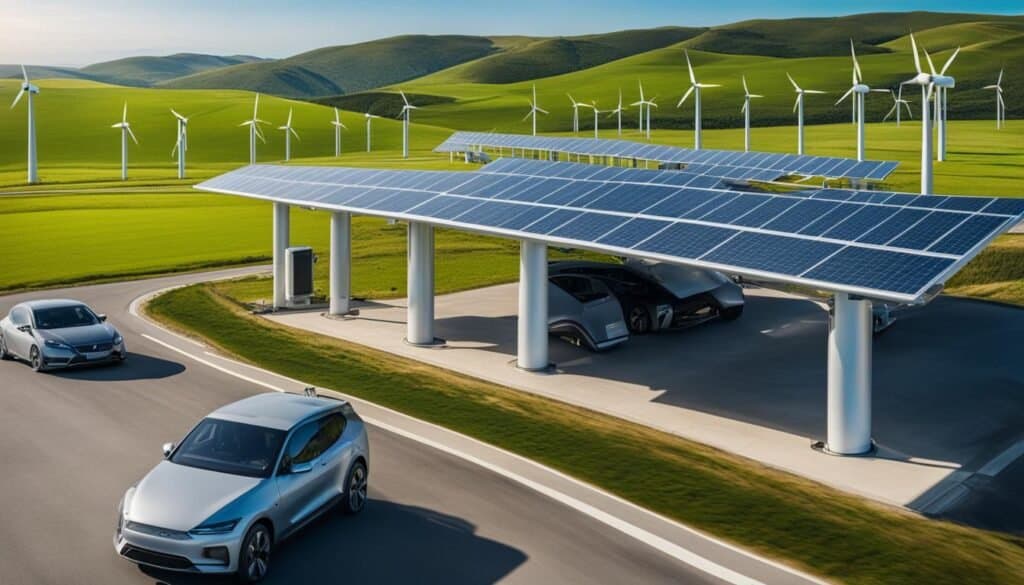As someone who cares deeply about the future of our planet, I am always fascinated by the advancements in renewable energy. Renewable resources are playing an increasingly important role in our journey towards environmental sustainability and energy transition. In this article, we will dive into the different types of renewable energy, such as wind power, solar power, and hydroelectric power, among others, and discuss the benefits they bring to society. With the successful integration of these sustainable energy sources, we are making strides towards a world powered by green energy and clean energy technologies.
Key Takeaways
- Renewable resources are crucial for achieving environmental sustainability and fostering energy transition.
- Types of renewable energy include wind power, solar power, hydroelectric, and more.
- Benefits of renewables range from reducing greenhouse gas emissions to promoting energy independence.
- Integration and continued development of clean energy technologies are pivotal for realizing the full potential of renewables.
- Policy support and incentives can play a significant role in driving renewable energy adoption.
Defining Renewable Energy and Its Importance
Renewable energy, as the name suggests, is derived from natural, self-replenishing sources that are inexhaustible over time yet have a finite energy flow per unit of time. These sources are vital for sustainable development, contributing significantly to energy efficiency and carbon neutrality. The major types of renewable energy include wind, solar, biomass (wood waste, biogas, biofuels), hydroelectric, and geothermal resources, all of which are critical in renewable energy explained.
Compared to non-renewable fuels, such as fossil fuels, renewable energy sources do not deplete and emit significantly fewer greenhouse gases. Consequently, they play a crucial role in energy security and greenhouse gas reduction in the United States and worldwide. In this quest, clean energy technologies are continuously advancing to harness the full potential of these natural resources and integrate them seamlessly into the existing energy grid.
NRF: Companies must align renewable energy purchases with broader corporate goals, like reducing greenhouse gas emissions, to ensure effective implementation.
Renewable energy is essential for paving the path towards a sustainable future, striking a balance between economic development and environmental protection.
The importance of renewable energy sources goes far beyond their environmentally-friendly characteristics. By investing in and promoting renewables, we can achieve diverse outcomes, such as job creation, improved public health, and insurance against volatile energy prices. Renewable energy is critical in our transition to a more sustainable, greener future.
- Wind power: harnessing the kinetic energy of moving air.
- Solar power: tapping into the sun’s rays to produce energy.
- Biomass: converting organic matter into energy.
- Hydroelectric: capitalizing on the force of moving water.
- Geothermal: leveraging the earth’s natural heat to generate power.
| Type of Renewable Energy | Energy Source | Environmental Impact | Potential |
|---|---|---|---|
| Wind | Air currents | Low emissions, potential wildlife disturbances | Abundant potential, especially in coastal and windy regions |
| Solar | Sunlight | Low emissions, land use considerations | Endless resource, suitable for large-scale projects and individual households |
| Biomass | Organic materials | Low emissions, but requires life-cycle management | Depending on specific geological conditions, potential for continuous power generation |
| Hydroelectric | Moving water | Low emissions, potential ecosystem disruptions | Dependent on specific geographical features (rivers, tides) |
| Geothermal | Earth’s heat | Low emissions, minimal surface impact | Depending on specific geological conditions, the potential for continuous power generation |
Renewable energy is essential to our sustainable development strategy. Harnessing these renewable resources will not only pave the way for a greener future, but also deliver tangible economic benefits and contribute to energy efficiency and carbon neutrality goals.
The Leading Role of Wind Power in Renewable Electricity
Wind power has secured its place as a top producer of renewable electricity, particularly due to the efficient conversion of kinetic energy from spinning blades into electrical power generated by wind turbines. Both onshore and offshore wind energy systems have contributed significantly to the growth and diversity of renewable electricity sources.
Onshore Wind Energy Conversion
The wind turbine is at the core of onshore wind energy conversion, which captures the wind’s kinetic energy and transforms it into usable electricity. This process involves turning a drive shaft attached to a generator, scaling up the voltage to meet electricity grid requirements, and contributing power to the electricity generation infrastructure.
Today’s Homeowner: For homes located in areas with consistent wind, residential wind turbines can supplement your home’s electricity needs. They harness kinetic energy from the wind and can work in tandem with other renewable energy sources like solar panels.
As a result, the onshore wind energy sector has become a driving force behind adopting renewable energy sources for electricity generation.
Offshore Wind Farms and Their Growing Influence
Offshore wind farms are on the rise, gaining recognition for their unique ability to harness strong ocean winds that are less accessible with onshore systems. Structurally similar to their onshore counterparts, offshore turbines also convert the wind’s kinetic energy into electric power, substantially contributing to growing renewable energy supplies.
Offshore wind farms are not only gaining popularity amongst renewable energy enthusiasts but are also making a significant impact on the energy sector as a whole. As technological advancements continue to drive the development and efficiency of these systems, their influence on the green energy market is expected to increase even further. Below is a snapshot of the U.S. installed capacity for onshore and offshore wind energy:
Here is a visual chart based on the data about the growth of wind power in the United States. The chart shows two key aspects:
- Annual Wind Power Generation (in Terawatt-hours), represented by blue bars, indicates the amount of electricity generated from wind power each year.
- Installed Wind Power Capacity (in Gigawatts), depicted by the red line, shows the wind power installations’ total capacity.
Wind power, specifically onshore and offshore turbines, continues to play an influential role in providing green, renewable electricity to the masses. By leveraging the natural force of the wind, these systems generate electricity with minimal environmental impact, helping to pave the way toward a cleaner, more sustainable future.
Embracing the Sun’s Power: Solar Energy Explained
Solar energy is a renewable and sustainable source of power that is harnessed through various technologies. Solar power systems generate electricity by utilizing the sun’s light and heat. As a versatile and eco-friendly alternative to traditional energy sources, solar energy has become increasingly popular in recent years. In this section, we’ll explore different solar technologies, including photovoltaic cells and solar thermal energy.
Photovoltaic Cells – Harnessing Light to Generate Electricity
Photovoltaic (PV) cells are the main component of solar panels. These cells are made of semiconductor materials, such as silicon, which convert sunlight directly into electricity. As sunlight hits the PV cells, it causes electrons in the semiconductor to move, generating an electric current. This process is known as the photovoltaic effect.
- Direct sunlight is absorbed by the PV cells.
- Electrons within the semiconductor start to move, creating an electric current.
- The current is collected by the solar panel’s electrical components and formed into electricity.
- The electricity produced can be used to power homes and businesses or even sent back to the grid for others to use.
The efficiency of photovoltaic cells varies depending on factors such as location and climate, but they still contribute significantly to the global energy mix. With technological advancements and the increasing affordability of solar panels, PV systems are becoming more accessible to homeowners and businesses.
Solar Thermal Energy and Solar Water Heating
Beyond photovoltaic systems, solar energy can also be harnessed through solar thermal means. Solar thermal energy involves capturing and storing heat from the sun, rather than converting light into electricity. There are various applications for solar thermal energy, ranging from passive solar home design to solar water heating systems.
Passive solar home design refers to methods and materials used in the construction of homes that effectively capture and store heat from the sun; this can be achieved by strategically placing windows, using heat-absorbing building materials, and incorporating thermal mass in the design.
Solar water heating systems use solar collectors to absorb the sun’s heat and transfer it to a storage tank. The heated water can then be used for domestic purposes, such as showering and washing dishes. These systems significantly reduce the need for conventional water heaters, which rely on fossil fuels or electricity. Homeowners can benefit from lower utility bills and reduce their carbon footprint by relying on solar thermal energy.
| Technology | Application | Benefits |
|---|---|---|
| Photovoltaic Cells | Electricity Generation | Zero Emissions, Renewable Source |
| Solar Thermal Energy | Home Heating and Solar Water Heating | Energy Efficiency, Lower Utility Bills |
In conclusion, solar energy is a diverse and environmentally friendly option for harnessing power from the sun. Homeowners and businesses can contribute to a greener, more sustainable future for all by utilizing either photovoltaic cells or solar thermal technology.
Hydropower: The Power of Moving Water

At its core, hydropower is the process of harnessing the movement of water to generate electricity. Unlike other renewable energy sources, such as solar and wind, which rely on intermittent weather conditions, hydropower has a fundamental advantage in that the constant flow of water in rivers and oceans can be utilized for continuous energy production.
Central to the production of hydropower are hydroelectric plants, commonly situated at strategically designed dams. These facilities capture the kinetic energy of moving water, which flows through turbines and generates electricity via a generator. Once electricity is generated, it is then transmitted to grids for distribution.
Another innovative facet of hydropower lies in tidal and wave power technologies. Both of these approaches take advantage of the oceans’ natural movements, providing other means of generating electricity. While not as widespread as traditional hydroelectric plants, they present exciting possibilities for the future of renewable energy.
Hydropower is among the most reliable and efficient sources of renewable energy, contributing a sizable percentage of the global energy mix.
As a large-scale, clean, and dependable form of energy generation, hydropower plays a critical role in supporting energy security and sustainability. Below are some notable advantages of hydropower that make it an essential component of the renewable energy landscape:
- High efficiency in converting kinetic energy into electricity
- Ability to cope with variable power demands through flexible water flow controls
- Contributes to water resource management and flood control measures
- Minimal greenhouse gas emissions when compared to fossil fuels
- Long operational lifespan of hydroelectric plants reduces the need for frequent upgrades or replacements
In conclusion, by tapping into the power of moving water, hydropower presents an essential renewable energy source with both established and emerging technologies. From traditional hydroelectric plants to innovative tidal and wave power, hydropower can significantly contribute to the global shift towards a more sustainable and clean energy future.
Biomass Energy: Turning Organic Matter into Power

Biomass energy is a renewable resource that contributes to our clean energy mix by producing power from organic matter. This organic matter may consist of plant-based materials or commercial and industrial waste, which are transformed into energy through combustion, gasification, and anaerobic digestion. Biomass power plants offer a sustainable, environmentally friendly approach to generating energy and managing waste while reducing the carbon footprint.
The Lifecycle of Biomass Fuels and Their Carbon Footprint
One of the critical advantages of biomass energy is its closed carbon cycle. When biomass fuels are burned, they release carbon dioxide (CO2), which growing plants take up. This cycle ensures that the CO2 emissions from biomass energy production are offset by the equivalent carbon uptake during the growth of new plants. This allows the biomass energy sector to maintain a balanced CO2 footprint.
“Biomass fuels’ closed carbon cycle offsets CO2 emissions through the regrowth of plants.”
Furthermore, the lifecycle of biomass fuels has additional environmental benefits. Using agricultural residues, forestry by-products, and waste materials reduces the demand for land, water, and other resources. Collecting, processing, and transporting biomass materials also create job opportunities within the renewable energy sector.
Bioenergy from Waste: A Double Win for the Environment
Waste-to-energy conversion is an essential aspect of the bioenergy industry, providing an effective solution for waste disposal while generating clean, renewable power. Biomass waste materials include agricultural residues, food waste, paper products, and wood processing residues. Converting these waste materials into bioenergy helps reduce landfill waste and offers a cleaner alternative to traditional fossil fuels.
- Processing agricultural residues into biofuel and biogas
- Utilizing food waste for anaerobic digestion to produce biogas
- Converting wood processing residues into biomass pellets or bio-oil
By harnessing the power of waste, the biomass energy sector contributes significantly to our renewable resources while simultaneously addressing environmental concerns.
The Quiet Giant: Geothermal Energy’s Potential

Geothermal energy harnesses the earth’s heat to generate power and offers a renewable and clean alternative to traditional energy sources. It operates continuously with minimal environmental impact, making it essential in moving towards sustainable energy solutions.
Geothermal Power Plants and Earth’s Heat
Geothermal power plants utilize the earth’s subsurface heat to produce electricity. Unlike other renewable energy sources, such as wind or solar power, geothermal energy is not affected by weather or light conditions fluctuations. This constant availability gives it a significant advantage over its renewable counterparts. In addition, geothermal power plants are relatively low-profile, reducing their environmental impact.
“Geothermal energy is an essential renewable resource, as it offers continuous, clean power generation with minimal ecological impact.”– National Renewable Energy Laboratory
- Advantages of geothermal power plants:
- Reliable and continuous energy production
- Low greenhouse gas emissions
- Minimum land use
Domestic Use of Geothermal Heat Pumps
Beyond electricity generation, geothermal energy also has practical applications for residential living. Geothermal heat pumps, for instance, utilize the earth’s constant below-ground temperature to heat and cool homes, reducing dependence on traditional HVAC systems. These pumps offer a sustainable, energy-efficient alternative for domestic home heating, substantially reducing energy consumption and greenhouse gas emissions.
| Geothermal Heat Pumps | Traditional HVAC System |
|---|---|
| Utilizes Earth’s consistent below-ground temperature | Dependent on external energy sources |
| Energy-efficient and reduces greenhouse gas emissions | Higher energy consumption and carbon footprint |
| Lower operating costs | Higher operating costs |
In conclusion, geothermal energy offers immense potential for clean and sustainable power production. With advantages like continuous electricity generation and practical applications for home heating solutions, it’s an essential component of the global push toward clean energy and environmental conservation.
The Untapped Potential of Tidal and Wave Energy

As the world shifts towards embracing renewable resources for sustainable power generation, greater attention is being directed towards the enormous potential of ocean energy. Among the various forms of ocean energy, tidal energy, and wave energy stand out as less explored options with immense capacity to provide clean, renewable electricity.
Derived from the natural movements of the ocean, tidal and wave energy use advanced technologies that share similarities with those employed in hydropower. These technologies enable efficient energy harvesting from oceanic forces, such as tides and waves, to generate electricity at tidal power stations.
Using tidal energy typically involves the construction of tidal barrages or underwater turbines that capture and convert the kinetic energy of moving water into usable electricity. On the other hand, wave energy harnesses the power of the ocean’s surface waves using floating or submerged devices that capture and convert wave motion into electricity.
“Tidal and wave energy have the potential to contribute more to the global renewable energy mix in the future.”
Though tidal and wave energy technologies are less established than other renewable resources, continuous advancements and innovations gradually lead to increased adoption worldwide. It is crucial to explore and invest in the untapped potential of these renewable energy sources to pave the way for a more sustainable future.
The Environmental and Economic Benefits of Renewable Energy

The transition towards renewable energy brings several notable environmental and economic benefits that ultimately contribute to a more sustainable future. Harnessing green energy minimizes greenhouse gas emissions and generates ample opportunities for economic growth and development.
Renewable energy offers a path towards a cleaner, greener future with the promise of economic prosperity and a healthier environment.
Let’s dive into some of the crucial advantages of investing in renewable energy sources:
- Environmental Benefits: Unlike fossil fuels, renewables come with minimal or zero emissions, reducing air and water pollution, thereby minimizing the impact on the atmosphere and biodiversity, using renewable energy aids in climate change mitigation measures, ensuring a more stable and healthy living environment.
- Economic Benefits: The renewable energy sector has consistently demonstrated substantial job creation potential, stimulating investment in local and regional economies. An increase in renewable energy investment leads to the growth of new industries. It supports sustainable development goals, mainly due to its distributed nature, which lessens the risk associated with geopolitical energy dependence.
- Energy Security: By relying on domestic renewable resources, nations can substantially reduce their dependency on imported fossil fuels, fortifying their energy security in the long run. This independence promotes resilience in their energy networks, allowing the nation to withstand external shocks and fluctuations in the global energy market.
- Green Innovation: The ongoing transition towards renewable energy stimulates technological advancements and innovation in clean energy production, storage, and consumption. New developments in energy harvesting and distribution provide sustainable solutions to some of the most pressing climate change challenges, keeping us on track to achieve environmental milestones.
| Environmental Benefits | Economic Benefits |
|---|---|
| Reduced greenhouse gas emissions | Job creation and investment |
| Decreased air and water pollution | Local and regional economic growth |
| Conservation of biodiversity | Increased energy security |
| Promotion of green innovation | Advancement in clean energy technology |
Adopting renewable energy sources provides many environmental and economic benefits that improve our energy infrastructure while mitigating the detrimental effects of fossil fuel consumption. Increasing investments in renewable energy technologies and supportive policy frameworks will accelerate the energy transition and culminate in a cleaner and more prosperous future for all.
A Greener Grid: Renewable Energy Integration and Storage
Integrating renewable energy sources, such as solar and wind power, into the existing electricity grid is essential in transitioning to a sustainable energy system. As the contribution of renewables increases, addressing the challenge of intermittency – the variability of energy generation from these sources – becomes even more crucial. To overcome this issue, advances in energy storage and grid integration technologies play a vital role.
Energy Storage Solutions like Solar Batteries
Energy storage systems, particularly solar batteries, have emerged as a promising solution to intermittent renewable energy generation. These batteries store excess energy produced when renewable sources like solar panels generate more electricity than households or the grid need. During periods of low production, the stored energy can then be used, ensuring a continuous power supply. This not only enhances energy consumption efficiency but also improves renewables integration into the grid.
“Solar batteries can store excess energy during times of high solar generation, providing a continuous and stable power supply to households and the grid, making renewable energy integration more effective.”
The Challenge of Intermittency and Advances in Technology
The intermittent nature of renewable energy sources such as wind and solar is a significant hurdle in their integration into a clean energy system. As the output of these sources depends on environmental factors like wind speed and sunlight intensity, energy generation is variable, posing a challenge to grid integration and management. However, recent advances in renewable energy technologies are continuously seeking to overcome this challenge and improve the efficiency and reliability of renewables.
- Better energy storage solutions: Developments in battery technology enable more efficient energy storage, including the advent of grid-scale storage systems that can store large amounts of renewable energy for use when natural conditions are not optimal.
- Smart grid management: Aided by sophisticated algorithms, grid operations are becoming smarter, enabling the flexible transmission and distribution of renewable energy and managing supply and demand more effectively.
- More efficient energy harvesting techniques: Ongoing research and improved materials are leading to more efficient energy capture from renewable sources like solar and wind, ensuring a more constant and stable output.
In summary, integrating renewable energy into the grid and mitigating the challenge of intermittency is paramount to optimizing the potential of clean energy technology. Advances in energy storage systems, like solar batteries, and improvements in grid management can help foster a stable and sustainable energy system, contributing to a greener and more environmentally responsible future.
Renewable Energy Policies and Incentives
As the world moves towards a clean energy future, the role of governmental and non-governmental organizations becomes even more critical. Adopting renewable energy sources is largely driven by policies and incentives to create a more sustainable and environmentally friendly society. In this section, we’ll discuss some of the key policies and initiatives to encourage the integration of renewable energy sources into our energy landscape.
One of the most significant policy tools driving renewable energy adoption is the Renewable Portfolio Standard (RPS). Each state designs its RPS, mandating a specified percentage of electricity sold by utilities to come from renewable sources. This promotes the growth of the renewable energy sector by encouraging investments and installation of renewable energy technologies.
According to the National Conference of State Legislatures, as of September 2021, 30 states, three territories, and the District of Columbia have renewable portfolio standards in place.
In addition to renewable portfolio standards, various renewable energy incentives are available to support both individuals and businesses adopting clean energy technologies. Some examples of such incentives include:
- Federal tax credits
- State-level tax incentives
- Grants and low-interest loans
- Rebates and net metering
These incentives help reduce the upfront costs and long-term expenses associated with renewable energy systems, making them more accessible and financially viable for consumers.
| Policy/Incentive | Description | Examples |
|---|---|---|
| RPS | Mandates utilities to achieve a specific percentage of their electricity sold from renewable sources | California’s goal to reach 100% clean energy by 2045 |
| Federal tax credits | Provides tax credits on federal income tax for renewable energy systems | Investment Tax Credit for solar energy systems |
| State-level tax incentives | Offers tax incentives for renewable energy systems at the state level | New York’s Solar Tax Credit |
| Grants and low-interest loans | Provides financial assistance to individuals, businesses, and organizations | USDA’s Rural Energy for America Program |
| Rebates and net metering | Offers rebates for renewable energy installations and payments for excess energy production | Austin Energy Solar Rebate Program |
Integrating renewable energy sources into our everyday lives requires concerted efforts from both the private and public sectors. Encouraging the development of renewable energy technologies through policies, standards, and incentives can pave the way for a greener, more sustainable future for all.
Conclusion on Renewable Resources
As we acknowledge the importance of sustainable development, transitioning to renewable resources becomes crucial for a clean energy future. Renewable energy offers numerous benefits, such as reducing greenhouse gas emissions and promoting energy independence. With diverse sources like wind, solar, hydroelectric, bioenergy, and tidal energy, we have great potential for meeting our energy needs while addressing the environmental sustainability challenges posed by climate change.
The energy transition has seen remarkable progress, but much work still needs to be done. Integrating renewable energy technologies into the electricity grid and developing effective storage solutions are essential in overcoming the intermittency challenge. This is necessary to ensure a reliable and consistent power supply that can match the demand and performance of conventional energy sources.
Finally, supportive policies and incentives are crucial in fostering renewable energy adoption and investment. By creating a favorable regulatory environment and encouraging citizens and businesses to embrace clean energy technologies, we can achieve significant milestones in our quest for a sustainable planet. Let us all continue working collectively towards mitigating the impacts of climate change and securing a cleaner, brighter future for generations to come.
FAQ on Types of Renewable Resources
Q: What is renewable energy?
A: Renewable energy is energy generated from natural resources like the sun, wind, water, and biofuel. These are naturally replenished and not depleted when used, unlike non-renewable resources such as petroleum and natural gas. This makes them a sustainable and clean energy source for the future.
Q: What are the types of renewable energy sources?
A: The most common types of renewable energy sources include solar energy (energy from the sun), wind energy, hydropower (water), geothermal energy (heat from within the earth), and biomass energy (organic material). Each of these sources provide unique benefits and opportunities in renewable energy development.
Q: How does renewable energy compare to non-renewable energy?
A: The fundamental difference between renewable and non-renewable energy lies in their availability and sustainability. Renewable energy resources are abundant and naturally replenished, making them a long-term energy solution. On the other hand, non-renewable resources like petroleum, coal, and natural gas are finite and could lead to energy scarcity in the future.
Q: Why is using renewable energy important?
A: Using renewable energy is beneficial for multiple reasons. It reduces our dependence on non-renewable resources, which are dwindling an alarmingly fast rate. Renewable energy also causes fewer emissions, thus helping mitigate climate change. Lastly, it promotes energy independence, which can boost the nation’s energy security.
Q: How much of the world’s energy comes from renewable sources?
A: According to the Energy Information Administration, about 11% of the world’s energy consumption comes from renewable sources. However, the role of renewable energy is expected to increase significantly in the coming years as more countries transition towards a sustainable energy future.
Q: What is the most widely used renewable energy source?
A: Currently, hydroelectric power is the most widely used renewable energy source worldwide, accounting for about 70% of the total renewable energy production. However, solar and wind energy are the fastest-growing sources of energy.
Q: What is the role of the Department of Energy when it comes to renewable resources?
A: The Department of Energy (DOE) plays a vital role in managing and enhancing the use of renewable energy resources. They fund and conduct research aimed at promoting energy efficiency and developing cost-effective renewable energy technologies. This helps the United States towards fulfilling their commitment to a renewable energy future.
Q: What is biofuel and how is it a renewable energy source?
A: Biofuel is a type of renewable energy source derived from living or recently living organisms such as plants. It can be used as an alternative to petroleum, being used in vehicles and in heating or energy generation. As the organisms it’s derived from can be regrown, it’s a sustainable energy source.
Q: How can renewable energy contribute to energy efficiency?
A: By utilizing renewable energy, it’s possible to increase energy efficiency. This is because renewable energy technologies often use less energy than traditional, non-renewable methods. Also, renewable energy sources are often located closer to where the energy is used, reducing transmission losses.
Q: Is renewable energy reliable?
A: Renewable energy is considered highly reliable. Unlike non-renewable resources that can fluctuate in price and availability, renewable resources like the sun and wind are consistent and inexhaustible. However, factors such as weather conditions and geographical locale can affect the availability of certain types of renewable energy.





Leave a Reply